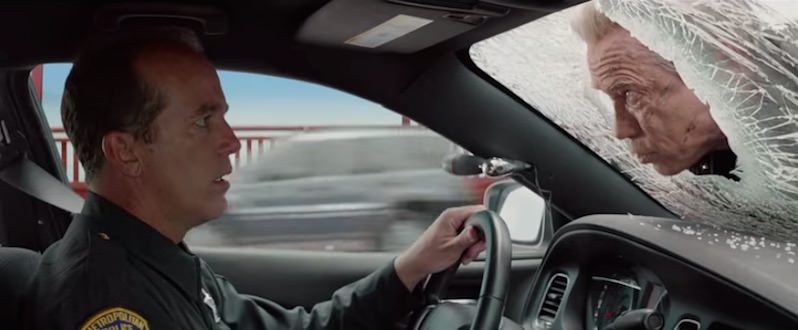Maybe It’s Time to Terminate
“Terminator Genisys” is unnecessarily complicated by so many time twists and warps that even an ardent fan of the franchise must admit that its future is behind it. IMDb
IMDb
In 1984 “The Terminator” franchise began its wonderful, horrible life—the wonderful consisting of its first two installments, the horrible its third and fourth—as a modern-day retelling of the annunciation and nativity of Jesus Christ.
Sarah Connor (Linda Hamilton) was the good-time girl and unlikely Mary Magdalene. Kyle Reese (Michael Biehn) was the time-travelling Joseph who comes from the future to sire her spawn, John Connor. (Note that sonny boy has the same initials as Jesus, and that his conception is not immaculate.) Also making the trip back in time to 1984 was The Terminator himself (Arnold Schwarzenegger), a cyborg thwarted in his mission to preempt JC’s conception.
“Terminator Genisys,” the fifth installment of the series, begins in 2029, time-travels back to 1984 and forward again to 2017. It boasts not one but two time machines, and only its screenwriters know for sure how many narrative timelines they engineered to wipe from the collective memory the third and fourth movies.
“Terminator Genisys” is thus neither a reboot nor a rethink of the franchise that made superstars of writer/director James Cameron and bodybuilder/actor Arnold Schwarzenegger. It is a return, of sorts, to the 1984 original, unnecessarily complicated by so many time twists and warps that even an ardent fan of the franchise must admit reluctantly that its future is behind it.
So why was it made? Hollywood’s fiduciary law demands that if it’s a brand, it gets a sequel. But consider how the multiplex has lately come to look like an oldies channel for films of the 1980s. A reboot of “Star Trek,” another episode of “Star Wars” on the way—naturally “The Terminator” had to fulfill its title character’s promise: “I’ll be back.” (In this context, filmmaker Robert Zemeckis’ vow that there will be no reboots of “Back to the Future” during his lifetime has a certain integrity.
What I most like about the “Star Trek” and “Terminator” movies is that they wed ideas with action and seem the most human of the sci-fi franchises, although in “Terminator’s” continuing saga of man versus machine, there is something contradictory about celebrating the superiority of human feelings in movies that come most alive in scenes depicting the mechanical perfection of cyborgs.
But then, the “Terminator” movies have always spoken with a forked tongue. Much as I enjoyed its first two iterations, I am still puzzling over the fact that in the original, Kyle Reese travels back to a time before he was born to live, procreate and get terminated before he is born. (A colleague once explained to me that the first law of time travel is that “a person can die before he is born as long as his personal timeline is unbroken.”) In “Terminator 2,” Sarah Connor, her son John and Schwarzenegger—this time as a human-loving cyborg—wage a lightning war to secure a lasting peace, a plot that appealed equally to the National Rifle Association and the anti-gun lobby.
The doublethink of “Terminator” movies is both familiar and provocative. Each film is like a comforting pizza upon which different toppings can be strewn, depending upon the current tastes. The “Genisys” of the new film refers to an operating system that “connects your car to your phone to your television.” It promises its users an integrated system—and centralizes their electronic devices to … well, all you need to know is that when a character calls this “a killer app,” it’s a double entendre.
The movie is not irredeemably bad. I’ll confess that I didn’t know how much I missed Schwarzenegger until I heard him explaining, in his inimitable Austrian-accented monotone, how he could simultaneously remember two timelines. He has a double role as both the late-model killer T-800 dispatched to kill Sarah (Hamilton look-alike Emilia Clarke) and his counterpart, a rusting cyborg who is Sarah’s protector.
In a film crowded with set pieces, the best has the two Arnold cyborgs battling each other on the apron outside the Griffith Park Observatory.
For a moment, when the human-loving cyborg sulks, “I’m old … but not obsolete,” I laughed, half hoping that there would be another occasion to hear him say, “Howl be Bach.”
Your support matters…Independent journalism is under threat and overshadowed by heavily funded mainstream media.
You can help level the playing field. Become a member.
Your tax-deductible contribution keeps us digging beneath the headlines to give you thought-provoking, investigative reporting and analysis that unearths what's really happening- without compromise.
Give today to support our courageous, independent journalists.






You need to be a supporter to comment.
There are currently no responses to this article.
Be the first to respond.